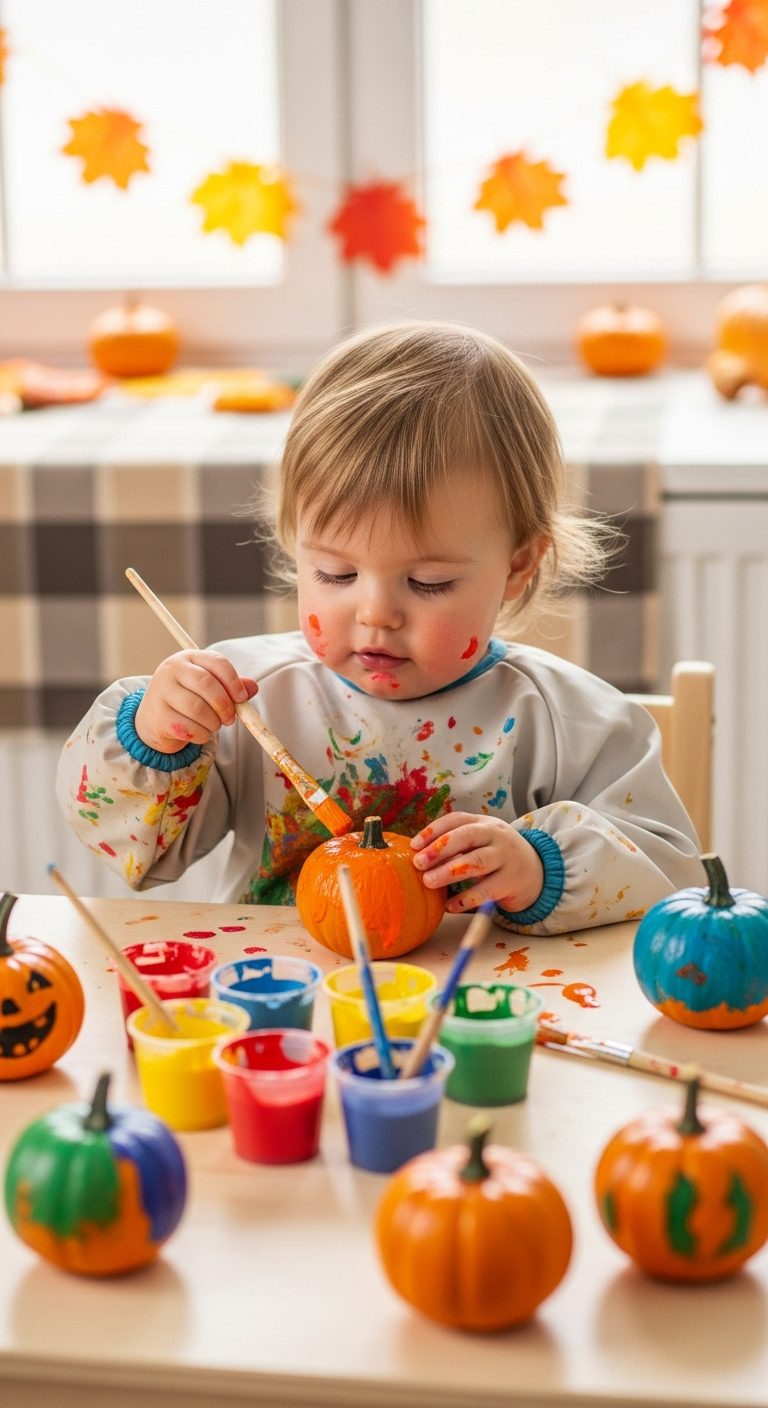
You want fall magic without scrubbing orange paint out of grout, right? Same. I love projects that let toddlers explore color while my kitchen stays, you know, recognizable. I’ve tested no-mess pumpkin painting tricks that actually work, and I’m sharing the exact setups, genius hacks, and easy printable-style templates you can recreate in minutes. Ready for cute pumpkins and clean floors?
I learned to prep once and relax while tiny hands create. I keep paints contained, tools simple, and cleanup laughably fast. Ever wondered why some setups feel chaotic while others feel calm? You set the calm with smart containment and kid-first tools, not more rules.
Why no-mess pumpkin painting beats carving (especially for little hands)

You want toddlers involved, but you also want your fingers. Painting wins for safety and attention span. No knives, no seeds, no tears—just color and giggles.
Painted pumpkins also last longer on the porch because you don’t cut them open. You control the theme every time with tapes, stickers, and stencils. Don’t you love a project that flexes for a sleepy Monday or a high-energy Saturday?
Your five-minute setup: the sanity-saving kit

You don’t need a craft store haul. You need a clean surface, washable color, and containment.
Must-haves for mess-free success:
- Washable tempera or paint sticks (kid-safe, vibrant, easy to clean).
- Painter’s tape + contact paper (for stencils and clean lines).
- Large tray or rimmed baking sheet (keeps everything in bounds).
- Non-slip mat or damp towel under the pumpkin (stops rolling).
- Baby wipes + old T-shirt smock (instant cleanup).
- Paper towels + small bowl of water (spot-clean brushes fast).
Nice-to-haves:
- Dot markers for quick coverage and controlled dabs.
- Foam stickers for sticker-resist patterns.
- Zip-top bags for sealed “squish” painting with paper templates.
Safety snapshot: Choose non-toxic, washable paints, avoid tiny loose embellishments, and keep a hand nearby when toddlers stand. You protect curiosity while you protect everything else.
Genius hacks that keep the paint where you want it
Tray + Tape + Towel (the stability trifecta)

Set a rimmed tray on the table. Place a damp towel on the tray for grip, then set the pumpkin on the towel. Add painter’s tape to anchor the stem if you need extra stability. You instantly stop rolling and sliding, so your toddler focuses on color, not chase scenes.
Sticker-Resist Faces (clean lines without stress)

Stick foam shapes or vinyl decals where you want eyes, nose, and mouth. Let your toddler dab paint everywhere. Peel stickers to reveal crisp shapes. Doesn’t that reveal feel like magic?
Contact Paper Stencils (custom templates on demand)

Cut contact paper into simple face parts, stars, stripes, or letters. Press it onto the pumpkin, paint over it, then peel. You control the design, and your toddler enjoys free painting without muddy edges.
Dot Markers & Paint Sticks (tools that behave)

Swap drippy brushes for dot markers or solid tempera sticks. These tools deliver color without puddles, which keeps designs bright and drying times short. IMO, paint sticks win when you need vivid, quick-dry coverage.
The Box Booth (containment that feels like a fort)
Place the pumpkin in a shallow cardboard box lined with scrap paper. Cut two window “doors” on the sides for little hands. Your painter feels cozy; your table feels safe. Ever notice how kids focus better in a defined space?
Two-Color Rule (the palette that prevents mud)
Offer two colors plus white. You reduce overmixing, and you still get bright, happy results. Add a third accent color only when the first layer dries.
Rinse-Free Brush Swap (faster than a sink run)

Set two small jars: one with clean water, one empty. Park a “used brush” cup on the tray. You swap brushes instead of rinsing nonstop, which keeps water off the table.
Pre-Wipe the Pumpkin (paint sticks better)
Wipe the pumpkin with a slightly damp cloth to remove dust. A clean surface takes paint faster and dries smoother. You spend ten seconds now and save minutes later.
Templates you can make in minutes (printable-style, kid-friendly)
You can print shapes or cut them yourself. Keep designs bold and simple for toddler success.
Face set (eyes, nose, mouth):
- Eyes: Triangles, circles, half-moons in 2–3 sizes.
- Noses: Triangle, oval, tiny heart.
- Mouths: Smile curve, zigzag “teeth,” oval “O.”
Pattern set:
- Stripes (1–2 cm tape strips).
- Polka dots (use hole-punched contact paper circles).
- Stars and hearts (trace cookie cutters onto contact paper).
Lettering set:
- B-O-O, H-I, or your child’s initials.
- Cut chunky letters so tiny hands don’t fight skinny edges.
How to “print” without a printer: Trace cookie cutters or jar lids onto contact paper or cardstock, then cut with scissors. You get reusable, sturdy templates that work on paper and pumpkins.
Step-by-step projects (no-mess recipes toddlers can finish)
1) Boo-Dot Pumpkin (dot markers)

You’ll use: Dot markers, contact paper letters B-O-O.
Steps:
- Stick letters across the pumpkin.
- Let your toddler dot around the letters in two colors.
- Peel letters to reveal a crisp “BOO”.
Why it works: Dots cover fast and dry quickly, so toddlers see results right away.
2) Stripe & Smile (painter’s tape)

You’ll use: Painter’s tape, paint sticks, foam triangle nose, sticker mouth.
Steps:
- Tape vertical or diagonal stripes.
- Hand your toddler two paint sticks to color between tapes.
- Peel tape and add nose + mouth stickers.
Hack: Keep stripes wide for easy coloring and bold impact.
3) Peekaboo Face Resist (contact paper)

You’ll use: Contact paper eyes + mouth, washable paint + brush.
Steps:
- Place face shapes on the pumpkin.
- Invite your toddler to paint over everything.
- Peel shapes for a classic jack-o’-lantern reveal.
Tip: Press edges firmly so paint doesn’t sneak underneath.
4) Rainbow Swirls (paint sticks)

You’ll use: Paint sticks in red, yellow, blue, white.
Steps:
- Demonstrate a big swirl.
- Let your toddler layer swirls around the pumpkin.
- Add white highlights to pop the colors.
Why it’s genius: Paint sticks won’t drip, so swirls stay crisp.
5) Polka-Party Pumpkin (stencil circles)

You’ll use: Contact paper dots, sponge dabbers, tray.
Steps:
- Stick dots randomly.
- Dab with two colors until dots feel covered.
- Peel for perfect polka dots.
Display idea: Add a single bow on the stem for a dressy look.
6) Nature Print Pumpkin (leaf “stamps”)

You’ll use: Clean leaves, paint on a foam plate, paper towel.
Steps:
- Press the leaf into paint, blot once.
- Press onto the pumpkin like a stamp.
- Repeat in a ring around the middle.
Safety note: Keep leaf shapes big, not fragile.
7) Candy-Corn Stripes (tape bands)

You’ll use: Tape bands, yellow + orange + white.
Steps:
- Tape three wide bands around the pumpkin.
- Paint each band a candy-corn color.
- Peel tape for neat tri-tone stripes.
Tip: Start with white at the top, then orange, then yellow at the bottom.
8) Silly Emoji Faces (sticker resist + paint sticks)

You’ll use: Circle eyes, eyebrow strips, smile/frown shapes.
Steps:
- Arrange sticker features.
- Color the background with one bright paint-stick color.
- Peel stickers to reveal goofy emojis.
Why kids love it: They recognize expressions and pick favorites.
9) Starry Night (stencil + splatter without splatter)
You’ll use: Star stencils, sponge, metallic paint stick.
Steps:
- Hold a star stencil flat.
- Dab gently with a barely damp sponge.
- Add metallic stick dots for “stars.”
Mess control: Keep the sponge almost dry for crisp edges.
10) Patchwork Quilt (low-tack tape grid)
You’ll use: Tape grid, three paint colors, brush or dabber.
Steps:
- Make a grid of squares.
- Fill random squares with color.
- Peel tape for a quilted look.
Talk it out: Name colors together as you fill squares.
Paints and tools: quick comparisons that matter
Washable Tempera:
- Best for: Big, soft coverage and brush play.
- Pros: Easy cleanup, vibrant, toddler-friendly.
- Watch: Thicker coats can smudge if you rush display time.
Paint Sticks (solid tempera):
- Best for: Zero-drip designs, stripes, swirls.
- Pros: Fast-drying, simple for small hands, great color payoff.
- Watch: You can’t blend as slowly as with wet paint.
Dot Markers:
- Best for: Controlled coverage with satisfying stamping.
- Pros: Less mess, fun motions, quick patterns.
- Watch: Dots can smear if you brush over them while wet.
Brushes vs. Sponges:
- Brushes build line control and detail.
- Sponges deliver fast fills and tidy edges.
- Choose based on attention span and the look you want.
Bottom line: For no-mess toddler pumpkin painting, start with paint sticks or dot markers, then add washable tempera for background fills. FYI, I keep all three, and I rotate them so kids stay engaged. 🙂
Zero-drama cleanup (and how to dry without smears)
You win cleanup during setup. You placed the pumpkin in a tray, right?
- Hand wipe first: Use a baby wipe on fingers, then a quick sink rinse.
- Tool toss zone: Park used brushes and sponges in an empty cup to avoid drips.
- Dry smart: Set the pumpkin on a jar ring or mug so painted sides don’t touch the table.
- Rotate once: Turn the pumpkin after ten minutes to air all sides evenly.
Stain SOS: Catch spills immediately with a soapy cloth. If paint hits clothes, rinse cold first, then wash warm. You beat stains with speed, not scrubbing marathons.
Troubleshooting like a pro
Paint won’t stick?
Wipe the surface with a slightly damp cloth to remove dust. If it still slips, lightly rough one small area with a dish scrubber and test again.
Colors look muddy?
Limit the palette to two colors + white and let layers dry a bit before adding more. You protect brightness with rest time.
Everything smears at pickup time?
Use paint sticks for the final details so the last marks dry fast. You keep little hands happy and designs crisp.
Toddler wants to eat the paint?
Redirect to dot markers or paint sticks and model “dot-dot here” or “swish-swish there.” Offer a dry brush as a prop if they want to copy you.
Display ideas that make your porch (or playroom) pop
You can style painted pumpkins without a Pinterest-level photoshoot.
- Crate Stack: Place two small crates and stagger pumpkins at different heights.
- Doormat Duo: Pair one mini pumpkin on each side of the mat with a simple sign.
- Bookshelf Row: Line three minis on a shelf with one leafy stem.
- Kitchen Island Runway: Park a tray with two pumpkins and a candle (battery only).
Add a date tag—“Fall 2025”—so your future self smiles at the memory. Doesn’t a tiny timestamp make keepsakes extra sweet?
The “templates on paper” option (totally mess-free for practice)
If your toddler feels unsure, start on paper pumpkins and move to the real thing later.
Make paper pumpkins fast:
- Trace a salad plate onto orange cardstock and cut.
- Add a green paper stem.
- Use the same stencils (eyes, stripes, letters) you made for the real pumpkin.
Try the Zip-Bag Squish:
- Slide the paper pumpkin into a zip-top bag with two paint blobs inside.
- Seal tightly and tape the bag to the table.
- Let your toddler squish colors around the template.
- Remove and air-dry for a glossy, mess-free masterpiece.
You build confidence on paper, then transfer the success to the pumpkin. That smooth ramp saves everyone’s nerves.
Sensory tweaks that keep kids engaged
Some toddlers crave texture; others prefer smooth tools. You can pivot on the fly.
- Texture lovers: Add a soft sponge or bubble wrap piece for stamping.
- Texture avoiders: Stick to paint sticks and dot markers for clean, predictable marks.
- Movement breaks: Invite a two-minute wiggle after each color. You reset focus without battles.
You match the tool to the child, not the other way around. Ever notice how that simple switch flips the energy from “meh” to “more”?
Quick photo tips (because you’ll want to remember this)
You can capture the cuteness without pausing the fun.
- Shoot near a window with overhead lights off.
- Get low to toddler eye level for genuine expressions.
- Focus on hands holding tools; those tiny grips melt hearts.
- Take three bursts at the moment they peel a stencil for the reveal.
Tag your album “No-Mess Pumpkin Painting – 2025” so you can find it later. I always add a caption like “First Boo-Dot!” because future me forgets the details, and captions save the day, IMO.
Checklist you can skim before you start
- Pick one method: paint sticks, dot markers, or washable tempera.
- Contain it: tray + towel + tape stops rolling and drips.
- Use stencils: contact paper or foam stickers give crisp shapes.
- Limit colors: two colors + white keep hues bright.
- Dry high: Set pumpkins on a jar ring to protect designs.
- Keep it fun: Smile, swap tools, and finish while interest feels high.
Final thoughts (and a tiny nudge)
You can set up no-mess pumpkin painting for toddlers in five minutes and enjoy real fall vibes without chaos. You guide the process with containment, simple tools, and bold templates, and your toddler brings the joy. That combo delivers pumpkins you’ll actually want on display.
Pick one project—Boo-Dot, Candy-Corn Stripes, or Emoji Faces—and try it this afternoon. Snap a pic, tape the date underneath, and stash a template for next time. If a dot lands on a sleeve, you’ve got wipes; if a giggle lands on your heart, you’ve got the memory that matters most. Happy painting!



